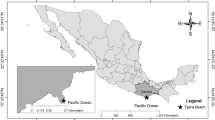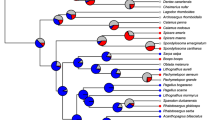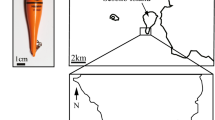Abstract
SEA anemones of the genus Actinia seem to be dioecious and reproduce sexually, yet males, females, and individuals without gonads brood juveniles for much of the year1–3. How this occurs is still not understood and knowledge on the subject is scant. Gillespie4 considered that eggs develop to ciliated blastulae and then directly into “a cylindrical form … which develops tentacular buds”. Chia and Rostron3 found no pre-planula larval stages in the coelen-terons of hundreds of specimens they examined and postulated that most embryos must leave the mother as morulae or blastulae and later resettle in the coelenteric cavities of other adult A. equina where they metamorphose to post-Edwardsia juveniles. According to this hypothesis, juveniles contained in an adult should be derived from a number of different parents and would be expected to show a range of phenotypes characteristic of the population rather than the brooding adult. Cain5 however found that in phenotypically varied populations of A. equina young anemones invariably had the same colour as the adult from which they were released. He considered it likely that A. equina is a protandric hermaphrodite which mainly self-fertilises and retains larvae within the parent, even though Carlgren2 thought this “hardly probable”.
This is a preview of subscription content, access via your institution
Access options
Subscribe to this journal
Receive 51 print issues and online access
$199.00 per year
only $3.90 per issue
Buy this article
- Purchase on Springer Link
- Instant access to full article PDF
Prices may be subject to local taxes which are calculated during checkout
Similar content being viewed by others
References
Gravier, C. J., C. r. hebd. Séanc. Acad. Sci., Paris, 162, 986 (1916).
Carlgren, O., Vidensk. Meddr dansk naturh. Foren., 77, 180 (1924).
Chia, F. S., and Rostron, M. A., J. mar. biol. Ass. U.K., 50, 253 (1970).
Gillespie, A. S., Proc. s. west. Nat. Un., 2, 111 (1931).
Cain, A. J., Nature, 247, 289 (1974).
Carlgren, O., K. svenska VetenskAkad. Handl., 6, 571 (1945).
Manwell, A., and Baker, C. M. A., Molecular Biology and the Origin of Species (Sidgewick and Jackson, London, 1970).
Shaw, C. R., and Prasad, R., Biochem. Genet., 4, 297 (1970).
Scandalios, J. G., Proc. natn. Acad. Sci. U.S.A., 53, 1035 (1965).
Kelly, E. P., Stormont, C., and Suzuki, Y., Anim. Blood Grps. biochem. Genet., 2, 135 (1971).
Francis, L., Biol. Bull., 144, 64, 73 (1973).
Bonnin, J. P., Bull. biol. Fr. Belg., 98, 225 (1964).
Dalyell, J. G., Rare and Remarkable Animals of Scotland, Represented from Living Subjects; with Practical Observations on Their Nature, 2, (Van Voorst, London, 1848).
Ashworth, J. H., and Annandale, N., Proc. R. Soc. Edinb., 295 (1906).
Comfort, A., Ageing: the Biology of Senescence (Routledge and Kegan Paul, London, 1964).
Fox, H. M., Nature, 198, 1222 (1964).
Krebs, C. J., Ecology; the Experimental Analysis of Distribution and Abundance (Harper and Row, New York, 1972).
Author information
Authors and Affiliations
Rights and permissions
About this article
Cite this article
OTTAWAY, J., KIRBY, G. Genetic relationships between brooding and brooded Actinia tenebrosa. Nature 255, 221–223 (1975). https://doi.org/10.1038/255221a0
Received:
Accepted:
Issue Date:
DOI: https://doi.org/10.1038/255221a0
This article is cited by
-
Multiple introductions and secondary dispersion of Tubastraea spp. in the Southwestern Atlantic
Scientific Reports (2019)
-
Reproductive biology and genetic diversity of the Sea Anemone Aulactinia stella (Verrill, 1864)
Hydrobiologia (2015)
-
The production of sexual and asexual larvae within single broods of the scleractinian coral, Pocillopora damicornis
Marine Biology (2010)
-
Mating systems in the sea anemone genus Epiactis
Marine Biology (1995)
-
Reproductive isolation with little genetic divergence between Urticina (=Tealia) felina and U. eques (Anthozoa: Actiniaria)
Marine Biology (1985)
Comments
By submitting a comment you agree to abide by our Terms and Community Guidelines. If you find something abusive or that does not comply with our terms or guidelines please flag it as inappropriate.



